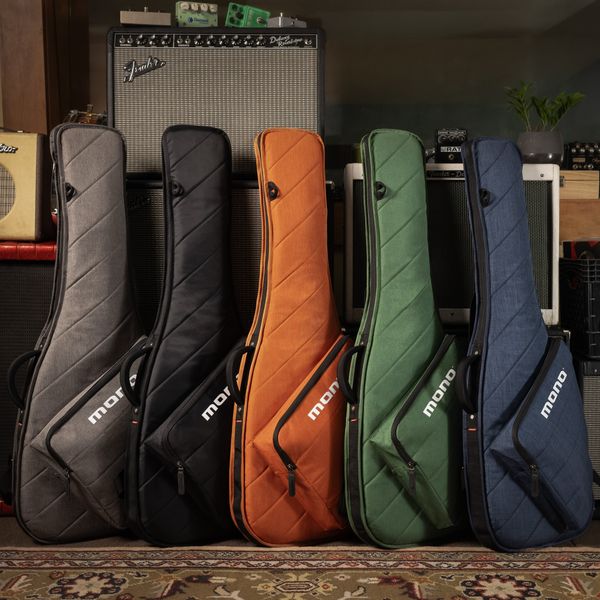The self-proclaimed “midrange mattress” makes a post-rock bed with an “Excalibur” Jazzmaster and some up-the-sleeve Strymon settings.
Dating back to the band’s origins in the early 2000s, Jamieson has played all sorts of guitars including classics like Les Pauls, Strats, and Telecasters—especially in the studio—but during a moment of self-reflection he surmised that he makes those traditional instruments appear miniature across the front of his tall frame. “The Jazzmaster just looks right on me,” says Jamieson. “They’re sexy and I think they look cool, but honestly I just subordinated it to whatever vision I had for our music, what we wanted to do with songs, and what I wanted to sonically articulate.”
Above is his Jazzmaster that did much of the heavy lifting in Caspian for at least a decade including Waking Season and Dust & Disquiet, along with their subsequent tours. The Frankenstein offset was a result of an “Excalibur” moment while blurry-eyed scrolling on eBay. “I couldn’t even recognize what I was seeing because I was browsing so fast and seeing so much, but I stopped when I saw this gorgeous instrument and I wanted to know more about it.”
Jamieson contacted the seller to find out he assembled it altogether from Warmoth parts. They conversed over Phil’s burgeoning love of ’80s/’90s indie Brit rock and recently entering post-rock via Godspeed You! Black Emperor. The seller really wanted Phil to have the guitar and told him to bide his time as he hadn’t received any bids. Hours before the auction ran out, someone offered a cool grand for the parts-master. The seller reached out to Phil and asked if he could match the bid because he wanted Jamieson to have the guitar. Phil said he couldn’t go over $250 (knowing he’d need $10 in his account for gas to drive to close the deal), and, to Phil’s disbelief, the seller sold him the guitar for $150.
It has a swamp-ash body and soapbar Seymour Duncan Vintage P-90 (bridge) and Custom P-90 (neck) pickups, which aren’t the ones that came with it. He removed the piezo and its on/off switch on the lower bout, as well as the guitar’s tone/volume controls.
While he has moved onto a different Jazzmaster for his main squeeze, Phil still acknowledges this one’s importance: “I cut my teeth in Caspian with this guitar. Through its tone and character, I found my place in our sound.”
The band incorporates a wide range of tunings, but some favorites that Phil employs are standard, drop C, drop D, and drop D with a high B or an A. (Phil says during headlining shows he might use a different tuning for every song.) All of his guitars currently take Ernie Ball Burly Slinkys (.011–.052).
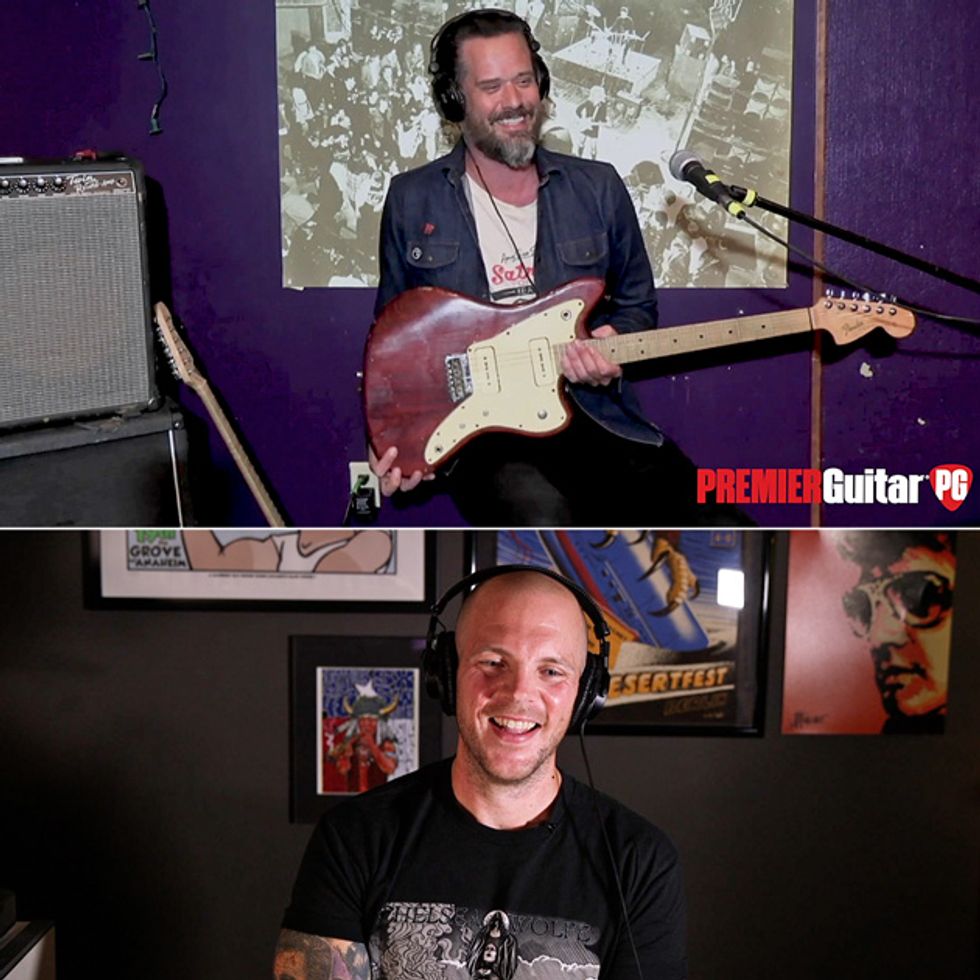
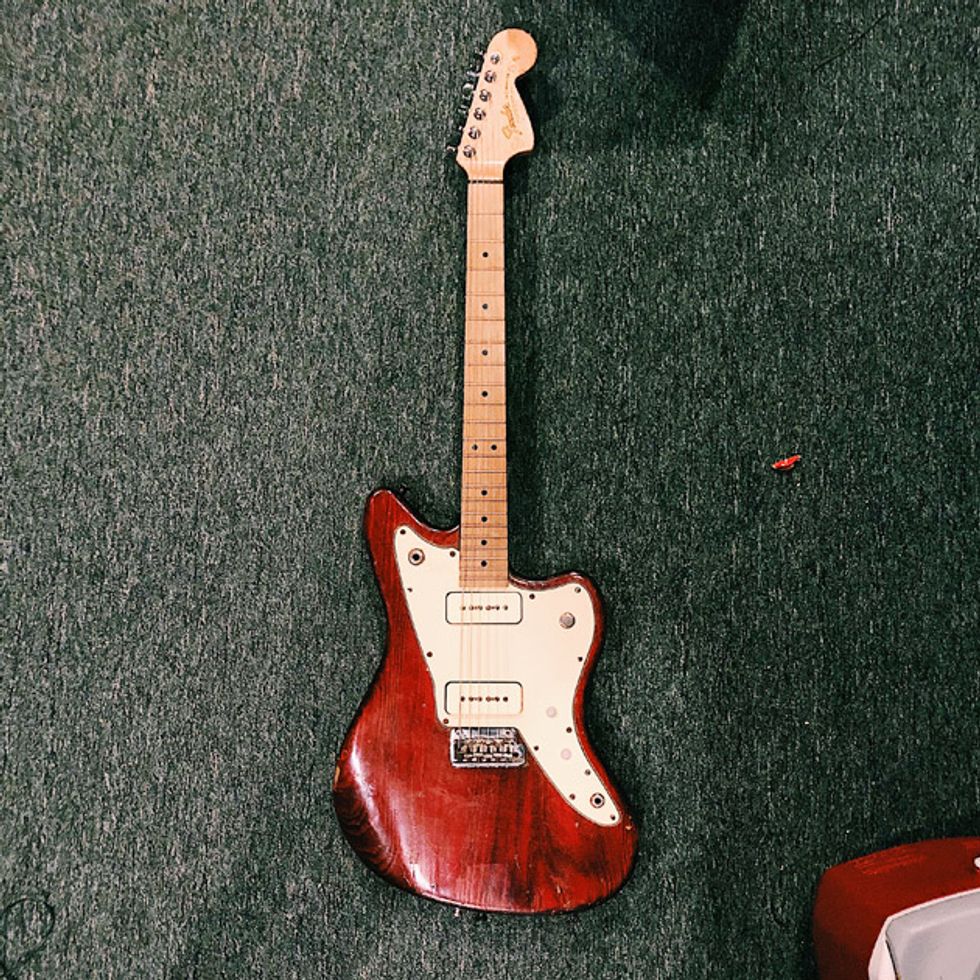
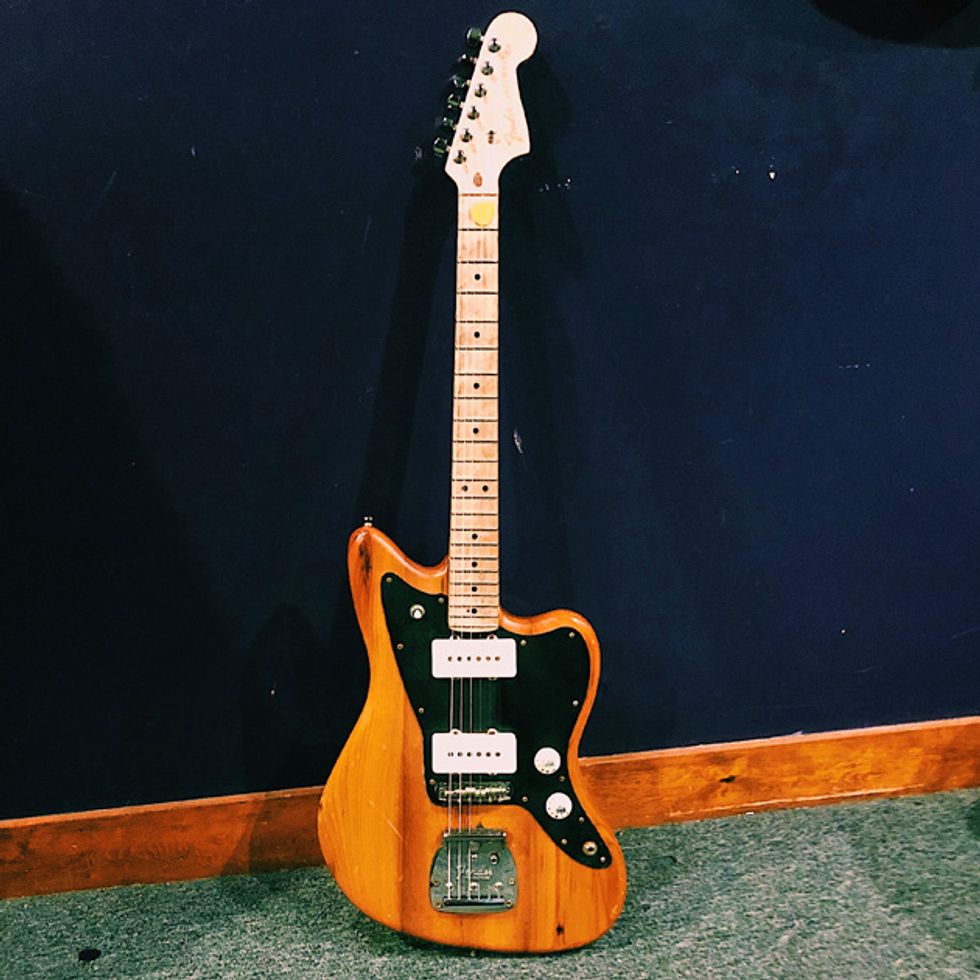
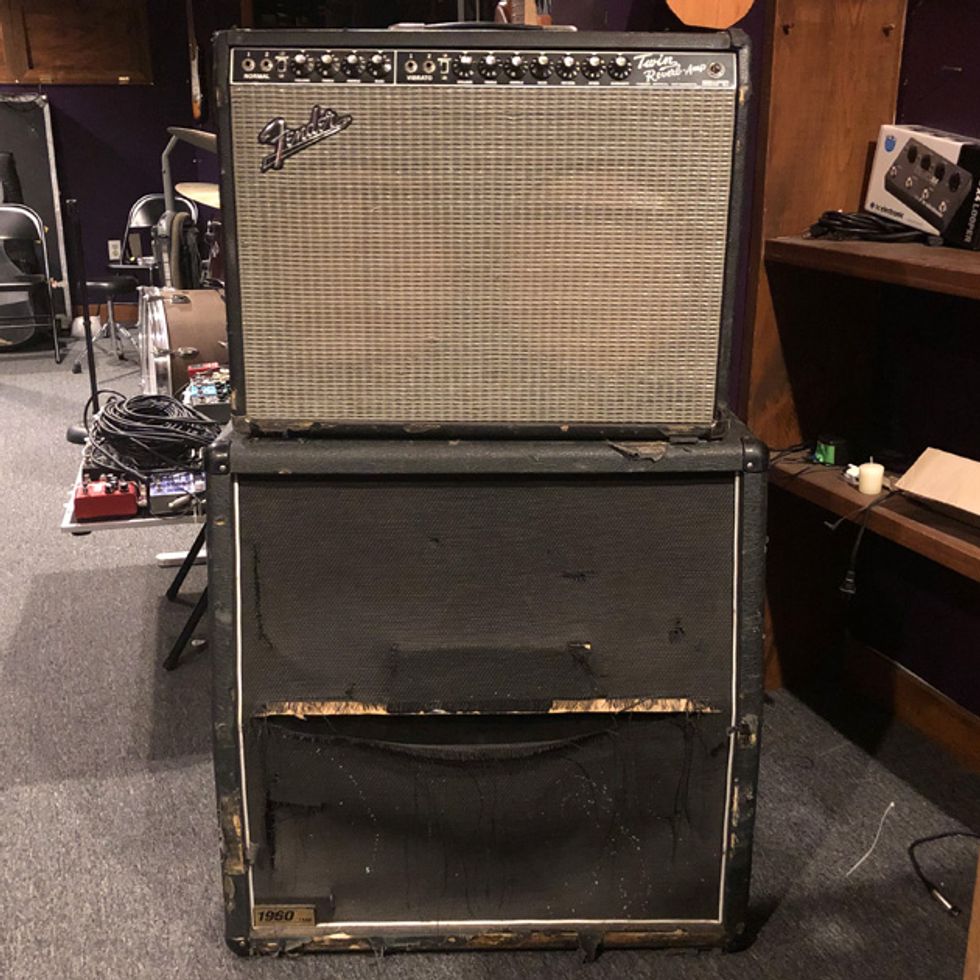
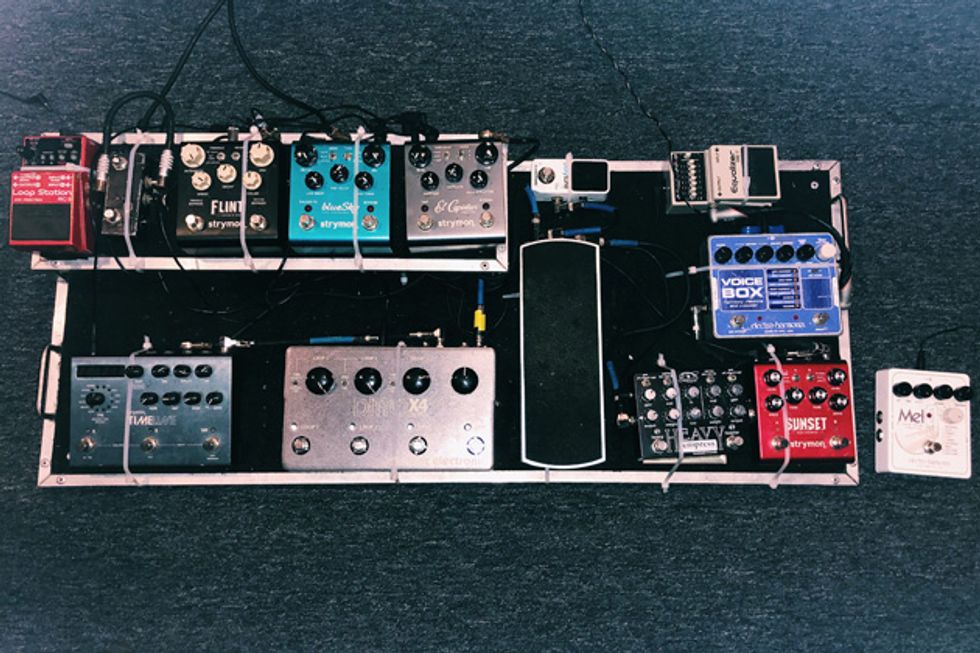
Click below to listen wherever you get your podcasts:
 |  |
 |  |
Bryan in a presidential pose before some of the boards at Blackbird Studio.
Take it from English cyclist Sir Dave Brailsford: With an all-encompassing approach to improving the marginal aspects of your methods, you can get quite the payoff on the quality of your endeavors. And that goes for recording, too.
Technology is a strange bedfellow in the arts. We’re either dazzled or disenchanted, love it or hate it, and the drive behind it all is a relentless need to gain a slight competitive edge on our own creativity—at least that’s how I think of it. Last month I wrote about the benefits of using a modeling microphone on a single source. This month, I want to expand that to a larger format.
Recently, I did a live recording and mixing masterclass with Universal Audio, Guitar Center Pro, and the Blackbird Academy back in Dallas, Texas (my hometown). The format: Record a live performance of a band including acoustic, electric, bass, and drums, plus vocals with additional synth tracks, and then immediately pivot to mixing in the box—all in front of a live audience. In addition, I also wanted to do something very different. I wanted to use modeling mics to record the drum kit and simultaneously use them without modeling for the live performance. My hope was that later during mixing, I would compare and contrast to see if I could get more of a “studio” sound.
There are many modeling microphone choices on the market today, mostly made by Slate, Antelope, and Universal Audio, ranging in list price from $129 to $1,500. For this masterclass, I used UA’s Standard Microphones with Hemisphere Modeling (starting at $129).
Live vs. Studio
Now for those of you that read my Dojo offerings regularly, you know I always emphasize mic placement as well as using as little EQ and dynamics processing as possible. In short, always start by taking as much time as you can to adjust the mic to get the best sound possible before reaching for the EQ knobs on any sound source. If you have more than one mic to choose from, switch mics and listen. Are you getting closer to the sound(s) you want?
After making sure the band was totally happy with their monitor mix and things sounded good in the house, the show began. To ensure that the tracks would be as clean as possible, I recorded the performances into my DAW with no modeling, EQ, or dynamics on the drums (or for the rest of the band). I did use some EQ and a little bit of dynamic control for the live show to keep the vocals out in front of the band.
The drum layout was as follows:
• Overheads: two SP-1s (spaced pair)
• Two rack toms and floor tom: three SD-7
• Kick drum: one SD-5
• Snare: one SD-3
Marginal Gains
Once I got the drum kit balanced in volume, I proceeded to bring in a pair of Neumann KH 310 monitors so the masterclass participants could hear what tracks sounded like in a more “studio” mix environment. I cycled through the various modeled mic profiles to hear the differences until we all reached a consensus as to which model worked best for each specific drum in the kit. (My picks: Neumann KM 54 for overheads, cream-colored Sennheiser MD 421 for toms, AKG D12 for kick, and SM57 for snare.) I could then toggle on and off all the profiles at once and hear a completely modeled-mic drum kit as opposed to the “natural” one. The results definitely raised some eyebrows and proved the efficacy of the “aggregation of marginal gains.” This term was coined by Sir Dave Brailsford, who catapulted British Cycling to legendary achievements and wins by choosing not to focus on big gains in a single area, but rather highly detail-oriented marginal gains in many areas (“The 1-Percent Factor”). Thus, by using seven modeled mics on the kit, the composite result was noticeably more flattering than without, and a more polished “studio” sound was achieved.
“Always start by taking as much time as you can to adjust the mic to get the best sound possible before reaching for the EQ knobs on any sound source.”
You may be asking, “Did the mics sound good in the house without any modeling?” Yes! I found them to be equally on par with the standard “live mic” stalwarts we all know. Now, this isn’t a review of the microphones as much as what I mentioned at the beginning—that technology can offer us unique possibilities if we start thinking outside conventional norms and use products outside their primary design. Look around your studio right now, or think about the gear and instruments you have. Can you challenge your creativity and try something new? Can you embrace the 1-Percent factor?
As for me, my next recorded live gig will very likely be with modeling mics!
Until next time, namaste.
Despite his early personal history in elementary school orchestra, Bohlinger says, “Classical musicians are a bit of a mystery to me, and probably most guitarists.”
Does the guitar player’s mind have the patience and focus of a classical musician, or are we on another tip altogether?
The first time I really played music was in fourth grade in my elementary school orchestra. Although I played terribly and was just one tiny cog in a huge musical machine—second to last chair in the second violin section out of 30 kids—being part of these incredible, interwoven melodies was a genuinely moving experience, regardless of how bad it must have sounded. But despite the personal history, classical musicians are a bit of a mystery to me, and probably most guitarists.
Firstly, classical music is too much work.
Great guitarists all have worked their asses off to master their instrument. But the most dedicated guitarists probably won’t put in half as much hard practice time as classical players. I first noticed this when I was touring with my friend and former bandmate Robert Martin—who’s worked with Frank Zappa, Stevie Nicks, Etta James, Bonnie Raitt, and lots of others. We could be in Venice with a free day to explore, and Robert would lock himself in a room with his French horn to practice. On the gig, he wasn’t even playing French horn, just piano and sax, but he carried that thing with him around the world because he had to get his lips on that horn daily. It was somewhere between a compulsion and rigid dedication. Robert told me he had been on this schedule since 1969, when he entered the Curtis Institute of Music, where he undertook intensive classical studies.
On Quora, I found a conversation around the question, “How much do professional musicians practice every day, or does performing take the place of practice?” Only classical musicians responded. The consensus was that orchestral musicians need to practice all the time to play at their absolute best. For symphonic violinists, the practice minimum seems to be three hours daily, but it’s not uncommon for violinists to practice eight hours per day and they rarely take a day off.
Sasha Romero, the principal trombonist in the MET Opera Orchestra, posted on the forum about her typical day. “I usually warm up/practice fundamentals for 30–60 minutes before starting a 2.5-hour rehearsal. Depending on the rep, I may play 5 minutes of that or pretty much every measure (trombones still have far fewer notes than string players). There’s often a second 2.5-hour rehearsal after lunch. After I get home, I might have one more hour-long practice session where I work on an upcoming rep or a recital or whatever is in the near future.”
On her lightest weeks, she posted that she practices about one-and-a-half hours minimum, and four hours max, every day. I could not imagine the misery of four hours alone in a room playing trombone scores. Lots of counting, a bit of monophonic blowing. Torture.
Ever notice when you walk into a venue to see an orchestra, they are all seated practicing right up until the conductor walks out? I always think, “The curtain is up. We can see you. If you don’t have it by now, just go with what you’ve got.” Meanwhile in the world of guitar, half the band is joking around or slugging down drinks right until curtain.
“I could not imagine the misery of four hours alone in a room playing trombone scores.”
Guitarists play what we want when we want. Yes, hard practice is part of the guitar journey, but even a raw guitarist, only playing for a short time with no formal training can play something that connects on the deepest level.
Second: Classical music limits your expression.
Classical players color in the lines. Their contribution to a composition, as one player on the forum put it, is that “the depth of color is up to you.… If Beethoven wants pianissimo, I must play the softest, most spine-tingling pianissimo anyone ever heard!”
Guitarists outside the classical world have carte blanche to do whatever they want. As Eddie Van Halen said: “You’ve only got 12 notes, and however you mix them up is your thing.” In our world, the most revered guitarists are players like Django Reinhardt, Wes Montgomery, Jeff Beck, and EVH. They are celebrated because they went where no one had gone before.
Guitar is a very personal instrument. We are all influenced by others, but ultimately, all guitarists have their own thing. If 10 guitar players lay down a track for a new song, you will get 10 wildly different interpretations.
The vast majority of my 10,000-plus hours were spent having fun, or, as SRV put it, “trying to pray through my guitar.” Guitar remains my therapist, entertainment, companion, and an expression of self. Classical musicianship feels more like servitude to me. Guitar feels like freedom. Classical feels like religion. Guitar feels like spirituality. I’m not knocking either one, but we know who our tribe is.
Your esteemed hosts of the 100 Guitarists podcast have been listening to Randy Rhoads’s body of work since they learned the word “pentatonic.” His short discography with Ozzy Osbourne has been emblazoned on both of our fingertips, and we’ve each put in our hours working out everything from the “Crazy Train” riff to the fingerpicked intro to “Diary of a Madman.” But in our extended Premier Guitar fam, we have an expert who’s been studying Randy’s licks since longer than either of us have been alive.
On this episode, we’re thrilled to be joined by Chris Shiflett—best known to you as the host of Shred with Shifty or as the Foo Fighters’s foremost expert on Randy Rhoads. Since growing up with these riffs in his ears, Shifty’s been making tokens of tribute to the later guitar slinger, from bespoke t-shirts to stuffed guitars.
Join us for Shiflett’s Randy Rhoads primer, learn why you should crank the outro to “S.A.T.O.” as loud as you can, and what Ozzy song makes this Foo cry.

Use code: PREMIERGUITAR10 for 10% off.
Offer valid until Dec 31, 2024. Visit http://bullheadamplification.com.
Always the drummer, Grohl thinks of the Foos’ approach to guitar parts as different limbs. Shiflett handles the 8th-note movement, Grohl pounds on the backbeats, and Smear simply crushes the downbeat. The result has shaped stadium rock for decades.
For the first time, Dave Grohl, Pat Smear, and Chris Shiflett discuss their shared 6-string history, breakdown some Foos riffs, and give insight on 30 years of rock and roll.
Over the past 30 years, Foo Fighters have become one of the most influential and important bands in rock and roll. Through countless gigs from clubs and theaters to arenas and stadiums, the trio of Dave Grohl, Pat Smear, and Chris Shiflett have developed a vocabulary that at this point comes together naturally. It’s a shared language that is always present but rarely (if ever) discussed. Until now.
Back in February, the trio convened in Studio 607 for a sitdown that is destined to be an instant classic among Shred with Shiftydiehards. Below are a few excerpts from the conversation—edited for clarity—that hit on what first inspired Dave and Pat to pick up a guitar, why there was so much feedback at Germs gigs, and that one time they ran into Joe Bonamassa at Guitar Center. You can watch the full episode on YouTube, where they break down “Hey, Johnny Park!,” “La Dee Da,” “Rope,” and so much more. — Jason Shadrick
Chris Shiflett: Alrighty, fellas, let's jump into it. You're in the hot seat now.
Dave Grohl: Oh God. Here we go.
Shiflett: Let's start off easy. What are you playing today?
Grohl: This is my signature DG-335 Epiphone and it's fucking rad. Love it. Been playing it on tour.
Pat Smear: It's not even out.
Dave: Is it not out yet?
Smear: No. Only rumors.
Shiflett: For the sake of this interview, it might be out by the time this airs, so we could be in a time machine. Pat, how did you go from being a guy who famously borrowed guitars at Germs gigs, didn't own one of your own, to the man we see here today with a barn full of guitars?
Smear: That's why, because I didn't even have my own guitar, so I'm like, well, now I need two.
Shiflett: … hundred … thousand. [laughs]. What are you playing today?
Smear: I am playing prototype number one, made by Mike McGuire from the Gibson Custom Shop. It's a Mini Barney Kessel Triburst prototype from 2011. May 11th, 2011.
Shiflett: Do you also have a baritone back there?
Smear: I do. My Hagstrom baritones are on tour, so that's my SG baritone. It's a funny guitar. I'm told that it was originally going to be a Buckethead model, his new model, and he just disappeared. So, they put it out as a baritone.
Grohl: He flew the coop?
Shiflett: When you first came back to the Foos, why did you land on a baritone so much of the time? Had you played much baritone prior to that?
Smear: I played one a little bit. I played one on The Color and the Shape album. That sounded great, but I never played it live. But then, what am I going to do? There are already two guitar players. When we were doing Wasting Light, I'm like, “What am I going to fit in here? Well, nobody's playing baritone. I'll pull that out.”
Grohl: And that’s the story of the Foo Fighters. [laughs]
Shiflett: What made you guys want to be guitar players in the first place? Because probably a lot of people don't know that the guitar actually came before drums, right?
Grohl: Yeah. My father was a classically trained flautist, and my mother bought him a nylon-string, which I don't think he ever played, but it sat in the corner of the room like a piece of furniture, and by the time I got to it I was maybe like eight or nine years old and it maybe had two or three strings on it. I picked it up and played “Smoke on the Water” or something like that. I understood where to put my hands on the frets, and then I was like, “wow, this is cool.”
Shiflett: Did you ever take lessons?
Grohl: I took a few lessons when I first started playing, and I was disappointed because I wanted to learn how to play chords so I could play along to things. I could hear the songs and sort of figure them out, but I was stuck with just getting my little-kid stuff together. And then the teacher started to try to teach me classical. I remember he taught me this thing. [plays short classical piece].
Smear: It worked! It's still there.
Grohl: I was like, fuck that shit.
“I don't even know what a good guitar sound is, but I do know when I play an old Trini through the Tone Master, I really have control over what I'm doing.” — Dave Grohl
Shiflett: What about you, Pat? What made you want to be a guitar player?
Smear: It was my sister Ingrid, who is a couple of years older. She had a nylon-string acoustic guitar in the house. I had those forced piano lessons when I was a kid, and I would cry through the whole thing. I hated it so much, and then I picked up the guitar and I'm like, “Oh, well, that's my thing.” But it was really [Alice Cooper’s] Love it to Death. That picture on the back cover. I'm like, I want to do this. I want to play that.
Shiflett: It's funny how that still informs your guitar choices. Who would you consider your primary guitar influences?
Grohl: I really liked Ace Frehley. I mean, I had a Beatles chord book, and that's where I was learning to play chords and stuff, but I never saw footage of the Beatles playing when I was eight or nine. I just thought Ace was so fucking cool looking, and I loved the way he stood, and I loved his Les Paul, and I thought that I could be a guitarist and look like him without all the fucking heels and the makeup and shit.
Smear: I don't know that I had one. I had a bunch. I had all the usual ones, but I thought Mick Ronson was the coolest, but as far as the playing, it was the Alice Cooper guys.
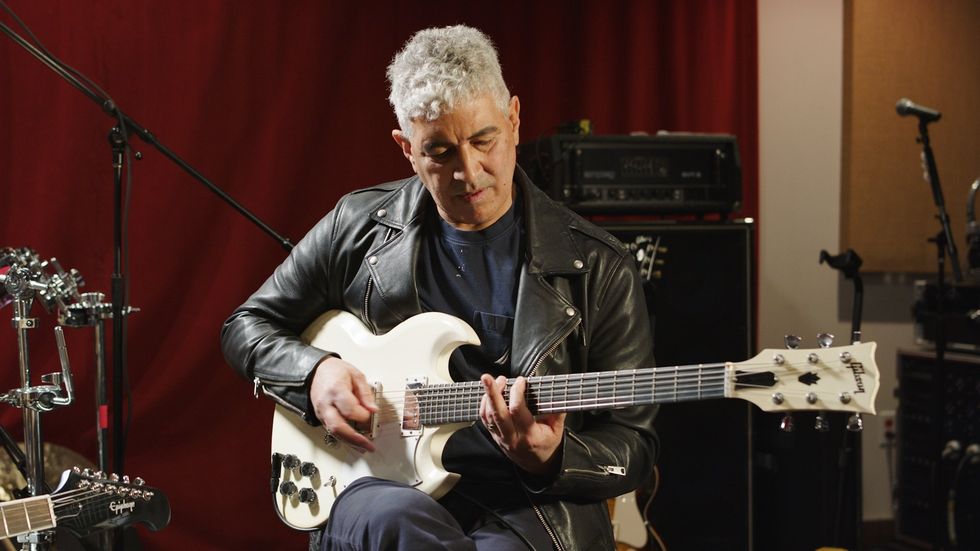
It wasn’t until the band started recording Wasting Light, that Pat Smear dived into the baritone guitar. “What am I going to fit in here?” thought Smear. “Well, nobody's playing baritone. I'll pull that out.”
Shiflett: When did you figure out that you needed a certain kind of gear to make it sound like the record?
Dave: It's funny. My mother bought me a Silvertone, like an old one from Sears with an amp in the case and everything, and it was cool. But then I found out about a distortion pedal. I don't know how, but I think I was in a music store and I saw one, and I said to my mom, I was like, “oh my God, mom, can I get it?” It was 30 bucks. It was an MXR. And I was like, “This is going to make it sound so much better.” And she's like, “Oh, good.” And we buy it and bring it home. After I plugged it in, she was like, “I thought you said it was going to make it sound good!”
Shiflett: It's distorting the sound. [Laughs]
Dave: Yeah, it doesn't sound good.
Shiflett: I had a little solid-state practice amp, and I'd go home and I'd try to play whatever I learned in my lesson and it wouldn't grit up at all. And you'd just kind of be confused. Why doesn't this sound like the Ozzy record? It doesn’t sound right!
Smear: I know! I never knew anything about that part of it.
Grohl: Well, you didn't even have any fucking gear. [Laughs]
Smear: I didn't even have gear. I didn't have a guitar. I didn't have an amp.
Shiflett: What was the time that you showed up at a Germs show and had to borrow somebody else's gear?
Smear: Well, that happened all the time, but the worst one was we were playing with X and I broke my guitar in the first song, and so I'm like, “I need Billy Zoom's guitar!” And, dude, I found out he was hiding in some closet with his guitar saying, “Keep him away from my fucking guitar.” I'm all drunk. I think somebody just taped it back together and we were okay.
Grohl: Is this why there was always so much fucking feedback at Germs gigs? You had no pedals, you would just crank the amp?
Smear: Well, if there was a pedal, I would just step on it and leave it there. And my favorite when I hear old tapes is tuning full volume with the pedal on.
Shiflett: Well, let's talk a little bit about your live rigs that you've gotten nowadays and how that's kind of changed over the years.
Smear: Yeah, Dave, talk about your live rig. [Laughs]
Grohl: Okay, just a disclaimer. I don't know a fucking thing. At first I was playing a Marshall, it was like a JCM 900 or something like that. For the first [Foo Fighters] album, that's what I was playing.
Shiflett: Pedals? No pedals?
Grohl: I really think I only had a RAT pedal and a fucking tuner. I don't think I had any delays or phasers or anything yet. I think I just had a RAT. Then eventually the Mesa/Boogies came along and it was like Dual Rectifiers and 4x12s and that kind of stuff. And then eventually I found one of those [Fender] Tone Masters at Norman’s [Rare Guitars]. And he was like, “These are great, man. This is what Aerosmith used on all of their cool shit.” I've stuck with them ever since. And the thing is that, I mean, I don't even know what a good guitar sound is, but I do know when I play an old Trini through that, I really have control over what I'm doing. I don't have any volume pedals or anything like that. I've got four channels of clean to dirty.
Shiflett: You do have a pretty straightforward live set up. Not a ton of pedals, just phaser and delay and a couple of things.
Grohl: And I can roll [the volume knob] a lot. I mean, that's the thing with the Trini is that they're kind of reactive. They're dynamic and you can make them do …
Shiflett: It leaves a lot in your hands.
Grohl: It does. And especially when you're running around the stage and I don't have 20 seconds to get back to a pedalboard, then I could just roll up and down and just do it in the hands.
“But it was really [Alice Cooper’s] Love it to Death. That picture on the back cover. I'm like, I want to do this. I want to play that.” — Pat Smear
Shiflett: It's interesting. When I joined the band I was playing through a Dual Rectifier and I think you were playing through a Dual Rectifier live, but I was surprised to learn that for Nothing Left to Lose you had used the Trini and old vintage AC-30s and Memory Man, and Hiwatts, so your studio thing and your live thing were very different.
Grohl: I remember having that conversation with my guitar tech at the time, and the justification was basically, if one of those things goes down while we're on the road, we're kind of screwed. And so the Rectifiers were really consistent and you didn't have a lot of problems with them, and if you needed to find another one, they were easy to find.
Smear: And they'd send them like that. [snaps fingers]
Grohl: Yeah, they'd be really quick. And we were just doing that because we were blazing through gigs so much.
Shiflett: I don't remember which tour cycle it was, but there was just a point where when you got that Tone Master and I came in with a Friedman and a something else or an AC, I forget what it was, all of a sudden it went from that to this completely other tone thing live.
Smear: We all had the Mesas.
Grohl: I think we had gotten to the point where we all had sort of three different sounds and three different duties in the band, and so we all started to focus more on that.
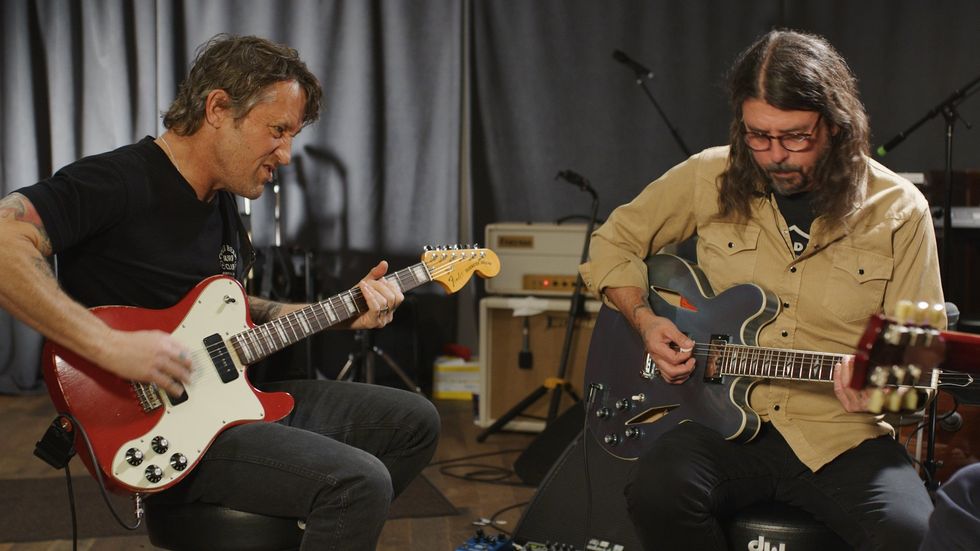
Both Grohl and Shiflett are armed with their respective signature guitars. Grohl’s recently released Epiphone DG-335 has been long requested by fans, while Shiflett’s Tele Deluxe will soon get a refresh.
Shiflett: I never had any effect pedals until I joined the band. Can you believe that?
Grohl: Wow.
Shiflett: Never, never played with a delay pedal or a flanger or any of that stuff in my life. And when we first started doing those rehearsals and there were songs like “Aurora” and “Generator” and stuff that had some color, that was when I had to first learn how to do that.
Grohl: I think that a lot of what we do comes from the studio. When we go in to record songs, the basic idea is usually pretty simple and we'll pull that together and then we start to color it with different things, different sections of the song, different effects, different tones, and things like that. And also the arrangement or composition of the three of us doing what we do since we don't want to just do the same thing all the time. I think it took 15 or 20 years for us to figure out the recipe or combination of what we do.
Shiflett: I wanted to talk to you about, “Hey, Johnny Park!” I remember when I bought that record, putting that song on and the big drums came in and then the guitars kicked in, it's like a guitar solo and there wasn't a lot of that in your music, and there really wasn't a lot of that even in alternative rock at that time. I was listening to the recorded version last night and it sounds like maybe it's like a Big Muff or something in that part? Do you remember what guitars you were playing? What amps, pedals, all that sort of stuff?
Grohl: I'm sure on that I was playing through a combination of amps. I think one was old Marshall. I think another might've been a Hiwatt. I don't remember what we had in there.
Smear: The only amp I remember was when you used that smokey cigarette amp. I don't even remember what song it was. But you used that on something.
Shiflett: What was your main go-to guitar back then?
Grohl: I was using the Trini a lot.
Shiflett: Oh, you had it even back then?
Grohl: Yeah, I got the Trini before Foo Fighters. I got it at this place called Southworth Guitars in Bethesda, Maryland, and there was a row of 335s and they're all red. They all kind of looked the same. And then there was this one with this different headstock and it had these diamond f-holes. I knew nothing about it. I didn't know anything about Trini Lopez. And it turned out great. It's the same one that I've used on fucking everything.
Shiflett: How many Trinis do you have? Vintage old ones?
Grohl: Maybe like five or six of them.
Shiflett: I didn't know if you were the Joe Bonamassa of Trinis.
Grohl: No, I’m not the Joe Bonamassa of anything.
Shiflett: I bet Joe Bonamassa is probably the Joe Bonamassa of Trinis. [Laughs.] That reminds me. My favorite guitar shopping moment with Pat was when we were making the last album and we were sitting there and we ran over to the rock and roll Guitar Center, and we went into the vintage room and we're looking at guitars.
Smear: Was Bonamassa there taking apart a Strat?
Shiflett: Yes, but the part that always sticks in my head is there was a 1997 Les Paul and they called it “vintage.” I was like, what? Really? God, how fucking vintage are we? [Laughs.]
Grohl: I just think we’re “used.”

